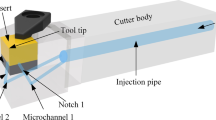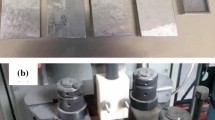Abstract
Cobalt-based superalloys are widely used in hot-end components of gas turbines due to their excellent elevated temperature mechanical properties. At present, cobalt-based superalloys are usually machined under cutting fluid, which will seriously pollute the environment and harm human health. Cryogenic cutting technology uses liquid nitrogen, supercritical carbon dioxide, etc. as the cooling medium, which has the advantages of environmental protection and energy conservation. In this paper, the cryogenic mechanical properties of cobalt-based superalloy GH605 were investigated, and then the cutting experiments were conducted under three different cooling and lubrication methods (flood condition, cryogenic minimum quantity lubrication, and liquid nitrogen) to investigate the cryogenic machinability and machining sustainability of GH605. The results show that cryogenic temperature can reduce the plasticity of GH605 but has little effect on the compressive yield strength and compressive strength. Compared with the cutting fluid, the cutting force of liquid nitrogen is reduced by up to 72.2%, the cutting-specific energy is reduced by about 83.9%, and the concentration of particulate matter such as PM2.5 generated during the processing can be decreased by more than 60%. The surface finish and consistency of cryogenic minimum quantity lubrication are better; the surface roughness is reduced by 0.4 ~ 20.4% at different cutting speeds. When the feed speed is greater than 0.10 mm/r, the work hardening degree decreases by 0.8 ~ 19.7%. Under the two cooling strategies, the chip surface is smooth and flat, chip breaking property is improved, but the machining noise is more than 100 dB.

























Similar content being viewed by others
Data availability
Not applicable.
References
Debnath S, Reddy MM, Yi QS (2014) Environmental friendly cutting fluids and cooling techniques in machining: a review. J Clean Prod 83:33–47
Ross NS, Mia M, Anwar S, G M, Saleh M, Ahmad S (2021) A hybrid approach of cooling lubrication for sustainable and optimized machining of Ni-based industrial alloy. J Clean Prod 321:128987
Carou D, Rubio EM, Davim JP (2015) A note on the use of the minimum quantity lubrication (MQL) system in turning. Ind Lubr Tribol 67:256–261
Kaynak Y, Lu T, Jawahir IS (2014) Cryogenic machining-induced surface integrity: a review and comparison with dry, MQL, and flood-cooled machining. Mach Sci Technol 18:149–198
Sarıkaya M, Yılmaz V, Güllü A (2016) Analysis of cutting parameters and cooling/lubrication methods for sustainable machining in turning of Haynes 25 superalloy. J Clean Prod 133:172–181
Liew PJ, Shaaroni A, Sidik NAC, Yan J (2017) An overview of current status of cutting fluids and cooling techniques of turning hard steel. Int J Heat Mass Transf 114:380–394
Amigo FJ, Urbikain G, Pereira O, Fernández-Lucio P, Fernández-Valdivielso A, de Lacalle LNL (2020) Combination of high feed turning with cryogenic cooling on Haynes 263 and Inconel 718 superalloys. J Manuf Process 58:208–222
Wang Y, Pang S, Yan P, Qiu T, Zhou H, Wang X (2022) Experimental research on cryogenic cutting performance of Ni-based superalloy GH4169. Int J Adv Manuf Technol 121:1–14
Jebaraj M, Pradeep Kumar M (2019) Effect of cryogenic CO2 and LN2 coolants in milling of aluminum alloy. Mater Manuf Process 34:511–520
Yuan S, Yan L, Liu W, Liu Q (2011) Effects of cooling air temperature on cryogenic machining of Ti–6Al–4V alloy. J Mater Process Technol 211:356–362
Viswanathan R, Ramesh S, Subburam V (2018) Measurement and optimization of performance characteristics in turning of Mg alloy under dry and MQL conditions. Measurement 120:107–113
Jamil M, Khan AM, Hegab H, Gong L, Mia M, Gupta MK, He N (2019) Effects of hybrid Al2O3-CNT nanofluids and cryogenic cooling on machining of Ti–6Al–4V. Int J Adv Manuf Technol 102:3895–3909
Korkmaz ME, Gupta MK, Boy M, Yaşar N, Krolczyk GM, Günay M (2021) Influence of duplex jets MQL and nano-MQL cooling system on machining performance of Nimonic 80A. J Manuf Process 69:112–124
Jawahir IS, Attia H, Biermann D, Duflou J, Klocke F, Meyer D, Newman ST, Pusavec F, Putz M, Rech J, Schulze V, Umbrello D (2016) Cryogenic manufacturing processes. CIRP Ann 65:713–736
Maruda R, Legutko S, Krolczyk G (2014) Effect of minimum uantity cooling lubrication (MQCL) on chip morphology and surface roughness in turning low carbon steels. Appl Mech Mater 657:38–42
Park K-H, Yang G-D, Suhaimi MA, Lee DY, Kim T-G, Kim D-W, Lee S-W (2015) The effect of cryogenic cooling and minimum quantity lubrication on end milling of titanium alloy Ti-6Al-4V. J Mech Sci Technol 29:5121–5126
K NSR, G M, Anwar S, Rahman MA, Erdi Korkmaz M, Gupta MK, Alfaify A, Mia M (2021) Investigation of surface modification and tool wear on milling Nimonic 80A under hybrid lubrication. Tribol Int 155:106762
Bagherzadeh A, Kuram E, Budak E (2021) Experimental evaluation of eco-friendly hybrid cooling methods in slot milling of titanium alloy. J Clean Prod 289:125817
Aramcharoen A (2016) Influence of cryogenic cooling on tool wear and chip formation in turning of titanium alloy. Procedia CIRP 46:83–86
Paturi UMR, B VD, Reddy NS (2021) Progress of machinability on the machining of Inconel 718: a comprehensive review on the perception of cleaner machining. Cleaner Engineering and Technology 5:100323
Kesavan J, Senthilkumar V (2020) Experimental investigations on cryo-machining of Hastelloy C-276 with tool wear characteristics. Sādhanā 45:240
Sarıkaya M, Güllü AJWAoS (2015) Examining of tool wear in cryogenic machining of cobalt-based haynes 25 superalloy. World Academy of Science, Engineering and Technology, International Journal of Chemical, Molecular, Nuclear, Materials and Metallurgical Engineering 9:984–988
Pušavec F, Kopac J (2011) Sustainability assessment: cryogenic machining of Inconel 718. Strojniski Vestnik 57:637–647
Kumar Gupta M, Korkmaz ME, Sarıkaya M, Krolczyk GM, Günay M (2022) In-process detection of cutting forces and cutting temperature signals in cryogenic assisted turning of titanium alloys: an analytical approach and experimental study. Mech Syst Signal Process 169:108772
Danish M, Gupta MK, Rubaiee S, Ahmed A, Sarıkaya M, Krolczyk GM (2022) Environmental, technological and economical aspects of cryogenic assisted hard machining operation of inconel 718: a step towards green manufacturing. J Clean Prod 337:130483
Jamil M, Zhao W, He N, Gupta MK, Sarikaya M, Khan AM, R SM, Siengchin S, Pimenov DY (2021) Sustainable milling of Ti–6Al–4V: a trade-off between energy efficiency, carbon emissions and machining characteristics under MQL and cryogenic environment. J Clean Prod 281:125374
Lee W-S, Lin C-F, Chen T-H, Chen H-W (2011) Dynamic mechanical behaviour and dislocation substructure evolution of Inconel 718 over wide temperature range. Mater Sci Eng A Struct Mater Properties Microstruct Process 528:6279–6286
Dadé M, Malaplate J, Garnier J, Barcelo F, Mompiou F, Wident P, Deschamps A (2018) Influence of temperature and strain rate on the deformation and damage mechanisms of oxide dispersion strengthened ferritic steels. Materialia 4:585–594
Godlevskiy VA (2016) Technological lubricating means: evolution of materials and ideas. Front Mech Eng 11:101–107
Dilip Jerold B, Pradeep Kumar M (2012) Experimental comparison of carbon-dioxide and liquid nitrogen cryogenic coolants in turning of AISI 1045 steel. Cryogenics 52:569–574
Varghese V, Ramesh MR, Chakradhar D (2018) Influence of deep cryogenic treatment on performance of cemented carbide (WC-Co) inserts during dry end milling of maraging steel. J Manuf Process 37:242–250
Tian X, Zhao J, Qin W, Gong F, Wang Y, Pan H (2017) Performance of ceramic tools in high-speed cutting iron-based superalloys. Mach Sci Technol 21:279–290
Yıldırım ÇV, Kıvak T, Sarıkaya M, Şirin Ş (2020) Evaluation of tool wear, surface roughness/topography and chip morphology when machining of Ni-based alloy 625 under MQL, cryogenic cooling and CryoMQL. J Market Res 9:2079–2092
Mirone G, Barbagallo R (2019) Coupling of temperature and strain in thermal softening of a stainless steel at low and high strain rates. Procedia Struct Integr 24:259–266
Musavi SH, Davoodi B, Niknam SA (2019) Effects of reinforced nanoparticles with surfactant on surface quality and chip formation morphology in MQL-turning of superalloys. J Manuf Process 40:128–139
Şirin Ş, Sarıkaya M, Yıldırım ÇV, Kıvak T (2021) Machinability performance of nickel alloy X-750 with SiAlON ceramic cutting tool under dry, MQL and hBN mixed nanofluid-MQL. Tribol Int 153:106673
Gupta MK, Song Q, Liu Z, Singh R, Sarikaya M, Khanna N (2020) Tribological behavior of textured tools in sustainable turning of nickel based super alloy. Tribol Int 155:106775
Pušavec F, Grguraš D, Koch M, Krajnik P (2019) Cooling capability of liquid nitrogen and carbon dioxide in cryogenic milling. CIRP Ann 68:73–76
Dilip Jerold B, Pradeep Kumar M (2012) Experimental comparison of carbon-dioxide and liquid nitrogen cryogenic coolants in turning of AISI 1045 steel. Cryogenics 52:569–574
Liang X, Liu Z (2018) Tool wear behaviors and corresponding machined surface topography during high-speed machining of Ti-6Al-4V with fine grain tools. Tribol Int 121:321–332
Wang F, Wang Y (2021) Comparison of cryogenic cooling strategy effects on machinability of milling nickel-based alloy. J Manuf Process 66:623–635
Gupta MK, Song Q, Liu Z, Sarikaya M, Jamil M, Mia M, Khanna N, Krolczyk GM (2021) Experimental characterisation of the performance of hybrid cryo-lubrication assisted turning of Ti–6Al–4V alloy. Tribol Int 153:106582
Rotella G, Lu T, Settineri L, Dillon OW, Jawahir IS (2012) Dry and cryogenic machining: comparison from the sustainability Perspective. In: Seliger G (ed) Sustainable manufacturing: shaping global value creation. Springer Berlin Heidelberg, Berlin, Heidelberg, pp 95–100
Shah P, Khanna N, Chetan (2020) Comprehensive machining analysis to establish cryogenic LN2 and LCO2 as sustainable cooling and lubrication techniques. Tribol Int 148:106314
Outeiro JC (2020) 11 - Residual stresses in machining. In: Silberschmidt VV (ed) Mechanics of materials in modern manufacturing methods and processing techniques. Elsevier, pp. 297–360
Liang X, Liu Z, Wang B (2019) State-of-the-art of surface integrity induced by tool wear effects in machining process of titanium and nickel alloys: A review. Measurement 132:150–181
Khaliq W, Zhang C, Jamil M, Khan AM (2020) Tool wear, surface quality, and residual stresses analysis of micro-machined additive manufactured Ti–6Al–4V under dry and MQL conditions. Tribol Int 151:106408
Trifunović M, Madić M, Janković P, Rodić D, Gostimirović M (2021) Investigation of cutting and specific cutting energy in turning of POM-C using a PCD tool: Analysis and some optimization aspects. J Clean Prod 303:127043
Bagaber SA, Yusoff AR (2017) Multi-objective optimization of cutting parameters to minimize power consumption in dry turning of stainless steel 316. J Clean Prod 157:30–46
J. Wang, Y. Zhang, Z. Zhang, W. Yu, A. Li, X. Gao, D. Lv, H. Zheng, X. Kou, Z. Xue (2022) Toxicology of respiratory system: Profiling chemicals in PM10 for molecular targets and adverse outcomes. Environment International 159: 107040
Cai L, Yang J, Cosky E, Xin R, Geng X, Ding Y (2022) Enhanced cerebral microbleeds by long-term air pollution exposure in spontaneously hypertensive rats. Neurol Res 44:196–205
Lawal SA, Choudhury IA, Nukman Y (2013) A critical assessment of lubrication techniques in machining processes: a case for minimum quantity lubrication using vegetable oil-based lubricant. J Clean Prod 41:210–221
Rahmani R, Aliabadi M, Golmohammadi R, Babamiri M, Farhadian M (2022) Body physiological responses of city bus drivers subjected to noise and vibration exposure in working environment. Heliyon 8:e10329
Mohamed A-MO, Paleologos EK, Howari FM (2021) Chapter 19 - noise pollution and its impact on human health and the environment. In: Mohamed A-MO, Paleologos EK, Howari FM (eds) Pollution assessment for sustainable practices in applied sciences and engineering. Butterworth-Heinemann, pp. 975–1026
Funding
This work was supported by the National Science and Technology Major Project of China [Y2019-VII-0018–0160].
Author information
Authors and Affiliations
Corresponding author
Ethics declarations
Ethical approval
Not applicable.
Consent to participate
Not applicable.
Consent to publish
Not applicable.
Competing interests
The authors declare no competing interests.
Additional information
Publisher's Note
Springer Nature remains neutral with regard to jurisdictional claims in published maps and institutional affiliations.
Rights and permissions
Springer Nature or its licensor (e.g. a society or other partner) holds exclusive rights to this article under a publishing agreement with the author(s) or other rightsholder(s); author self-archiving of the accepted manuscript version of this article is solely governed by the terms of such publishing agreement and applicable law.
About this article
Cite this article
Dai, Z., Yan, P., Chen, H. et al. Investigation of machining property and sustainability performance of cryogenic turning of GH605 superalloy. Int J Adv Manuf Technol 131, 2165–2189 (2024). https://doi.org/10.1007/s00170-023-10816-4
Received:
Accepted:
Published:
Issue Date:
DOI: https://doi.org/10.1007/s00170-023-10816-4




